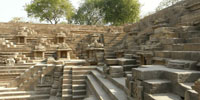
The Sun Temple - Beginning of Golden 'Solanki' Dynasty
Modhera (Mahesana), India
05 jan 2008, 1300 IST (+5.30)
© 2008 Harshal Purohit, All Rights Reserved.
The Sun Temple – Modhera means a devotional poetry depicted in the stones of time The Sun Temple of Modhera is a resplendent example of decorated stones. It is 35 KM far from Mehsana- then capital of North Gujarat at then bank of the river Pushpavati in the state of Gujarat, India.
The History: The ancient name of Modhera is believed to be “Modherak” or “Moherak” Modherak means “The hill of dead”. It is said that the villages was civilized for several times in the past. According to the old manuscripts, its second name is “Bhagvad Gram”. According to Skandhpurana and Brahmapurana, the area surrounding Modhera was known as “Dharmaranya Kshetra – Dharma (meaning one is performing according to his duty only) was prevailed in the area. Legend had it that the village was gifted to Modha Brahmin – a cast of Brahmin at the time of a marriage of King Rama and Queen Sita. The temple of the godess of Modheshwari is a supporting proof of this tale. She is worshipped ancestrally by Hindu Gujarati casts namely Modh Brahmin, Modh Vanik and Modh Modi. It is believed to be built in 1026 AD by Bhimadeva – King of the Solanki Rajput clan. There are three sun temples of India – Markand mandir of Kashmir (Extreme North of India), Sun Temple of Konark (in Orissa – on eastern coastal of India) and Sun Temple of Modhera (in Western part of India). The Sun Temple of Modhera has special relation with that of Konark (i.e. East meets West).
The architecture of the Sun Temple:
If we evaluate then temple according to artistic and architectural points of view, it looks to be situated on rising plateau of a hill i. e it stands high on a plinth overlooking a deep stone – steeped tank. The temple is decided to the Sun-God, Surya. The Sun Temple contains three parts- Garbhgruh (The interior- The Sanctum Santorum), Antaral (The Hall). The Sun Temple has a rectangular step tank or Surya Kund with about 108 shrines. Larger shrines to Vishnu, Ganesha and then Natraja incarnation of Shiva in tandav stand on three sides of the Surya kund, with the Sabha Mandap of then principal temple soaring on the fourth side with 52 pillars carved in intricate detail depiction tales from Ramayana and Mahabharata. The outer facades have a string of friezes and above that is the mandovara with excellent carvings of gods and goddesses. Between then Sabha Mandapa and then sanctum sanctorum is a hall with pillars and arches and then walls have 12 niches showing the different aspects of the Sun Gold in each month. The outer walls are filled with sculptures of Surya and other gods. In another part of then temple you can see a whole Kama Sutra of traditional erotic sculptures in a style that of Khajuraho and Konark. Unlike Konark which rests on 12 wheels of a chariot, Modhera has built on the petals of a lotus which runs then whole length of the temple. The Sanctum Sanctorum was designed in such a way that the rays of the rising and setting sun on the day of equinox, fell on the bejeweled statue built by the Surya Vanshi Solanki Rajputs in honour of their ancestral God. Today there is a no original impression of The sun in this temple but they are carced elsewhere in other parts of the temple.
The Surya Kund:
The Suryakunda is in front of the temple. It is also known as Rama-kunda and it is the only temple in India having a huge kund- a reservoir or pond. It is rectangular and measures 176 feet north to south, 120 feet east to west. It has many terraces and steps leading to the water level. On its sides and corners are various small shrines with the images of gods and goddesses namely Jalasayi Vishnu, Trivikrama, Goddess Shitala etc. There are 108 shrinies of the Lord Shiva corresponding to 108 auspicious numbers of pebbles in Rudraksh Mala. The pilgrims took their bath in this holy pond and got rid of sins.
Lat: 23° 35' 0.67" N
Long: 72° 7' 59.5" E
Elevation: 98m
Precision is: Unknown / Undeclared.


 Tap or click the zoom icon in the bottom right corner of the picture to switch between in-page and fullscreen view
Tap or click the zoom icon in the bottom right corner of the picture to switch between in-page and fullscreen view